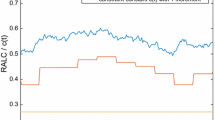Abstract
This paper is concerned with an investor trading in multiple securities over many time periods in order to meet an outstanding liability at some future date. The investor is concerned with maximizing the expected profits from portfolio rebalancing under an initial wealth restriction to meet the future liabilities. We formulate the problem as a discrete-time stochastic optimization model and allow asset prices to have continuous probability distributions on compact domains. For the case of Markovian price uncertainty and convex terminal liability, we develop a simplicial approximation, under which bounds on the problem can be computed efficiently. Computations only require evaluating a dynamic programming recursion, which thus, allows its application to problems with a large number of trading periods. The bounds are tight in that they are exact in certain cases. Numerical results are given to demonstrate the computational efficiency of the procedure.
Similar content being viewed by others
References
C.D. Aliprantis, D.J. Brown, and J. Werner, “Minimum-cost portfolio insurance,” Journal of Economic Dynamics and Control, vol. 24, no. 11, pp. 1703–1719, 2000.
E.J. Anderson and P. Nash, Linear Programming in Infinite-Dimensional Spaces, John Wiley and Sons, 1987.
J.R. Birge and R.J-B. Wets, “Designing approximation schemes for stochastic optimization problems, in particular for stochastic programs with recourse,” Mathematical Programming Study, vol. 27, pp. 54–102, 1986.
J.R. Birge and R.J-B. Wets, “Computing Bounds for Stochastic Programming Problems by Means of a Generalized Moment Problem,” Mathematics of Operations Research, vol. 12, pp. 149–162, 1987.
Black, F. and M. Scholes, The Pricing of Options and Corporate Liabilities, Journal of Political Economy, 81, pp. 637–654, 1973.
J.C. Cox, S. Ross, and M. Rubinstein, “Options pricing: A simplified approach,” J. Financial Economics, vol. 7, pp. 229–263, 1979.
G.B. Dantzig and P.W. Glynn, “Parallel processors for planning under uncertainty,” Annals of Operations Research, vol. 22, pp. 1–21, 1990.
M.A.H. Dempster, “Introduction to stochastic programming,” in Stochastic Programming, M.A.H. Dempster (ed.), Academic Press: London, 1980, pp. 3–59.
N.C.P. Edirisinghe, “Arbitrage-free pricing under transaction costs via generalized moment problems,” Presentation at the Tenth International Conference on Stochastic Programming, Oct 11–15, Tucson, AZ, USA, 2004.
C. Edirisinghe, V. Naik, and R. Uppal, “Optimal replication of options with transactions costs and trading restrictions,” Journal of Financial and Quantitative Analysis, vol. 28, pp. 117–138, 1993.
N.C.P. Edirisinghe and G.-M. You, “Second-order Scenario Approximation and Refinement in Optimization under Uncertainty,” Annals of Operations Research, vol. 19, pp. 314–340, 1996.
N.C.P. Edirisinghe and W.T. Ziemba, “Tight Bounds For Stochastic Convex Programs,” Operations Research, vol. 40, pp. 660–677, 1992.
N.C.P. Edirisinghe and W.T. Ziemba, “Bounds For Two-Stage Stochastic Programs With Fixed Recourse,” Mathematics of Operations Research, vol. 19, pp. 292–313, 1994a.
N.C.P. Edirisinghe and W.T. Ziemba, “Bounding the Expectation of a Saddle Function, With Application to Stochastic Programming,” Mathematics of Operations Research, vol. 19, pp. 314–340, 1994b.
Y. Ermoliev and A. Gaivoronsky, “Stochastic quasigradient methods and their implementation,” in Numerical techniques for stochastic optimization, Y. Ermoliev and R.J-B. Wets (Eds.), Springer-Verlag, 1988.
Y. Ermoliev and R. J-B. Wets, Numerical Techniques for Stochastic Optimization, Springer-Verlag, 1988.
K. Frauendorfer, “SLP Recourse Problems with Arbitrary Multivariate Distributions—the Dependent Case,” Mathematics of Operations Research, vol. 13, pp. 377–394, 1988.
K. Frauendorfer, Stochastic Two-Stage Programming, Lecture Notes in Economics and Mathematical Systems, Springer-Verlag, 1992.
H. Gassmann and W.T. Ziemba, “A Tight Upper Bound for the Expectation of a Convex Function of a Multivariate Random Variable,” Mathematical Programming Study, vol. 27, pp. 39–53, 1986.
H. He and N.D. Pearson, “Consumption and portfolio policies with incomplete markets and short-sale constraints: The infinite dimensional case,” Journal of Economic Theory, vol. 54, pp. 259–304, 1991.
J.L. Higle and S. Sen, “Stochastic decomposition: An algorithm for two-stage stochastic linear programs with recourse,” Mathematics of Operations Research, vol. 16, pp. 650–669, 1991.
J. Hull, “Options, futures, and other derivative securities,” Prentice Hall: Englewood Cliffs, N.J., 1989.
P. Kall, “Stochastic Programming with Recourse: Upper Bounds and Moment Problems—A Review. in Advances in Mathematical Optimization and Related Topics. J. Guddat, P. Kall, K. Lommatzsch, M. Vlach, and K. Zimmermann (Eds.) Akademie-Verlag: Berlin, 1987.
J. Kemperman, “The General Moment Problem. A Geometric Approach,” Annals of Mathematical Statistics, vol. 39, pp. 93–112, 1968.
A.J. King, “Duality and martingales: A stochastic programming perspective on contingent claims,” Mathematical Programming, vol. 91, pp. 543–562, 2002.
A. Madansky, “Bounds on the expectation of a convex function of a multivariate random variable,” Annals of Mathematical Statistics, vol. 30, pp. 743–746, 1959.
J. Mulvey and H. Vladimirou, “Stochastic network programming for financial planning under uncertainty,” Management Science, vol. 18, pp. 1642–1664, 1992.
C. Munk, “Optimal consumption/investment policies with undiversifiable income risk and liquidity constraints,” Journal of Economic Dynamics and Control, vol. 24, no. 9, pp. 1315–1343, 2000.
V. Naik and R. Uppal, “Leverage Constraints and the Optimal Hedging of Stock and Bond Options,” Journal of Financial and Quantitative Optimization, vol. 29, pp. 199–222, 1994.
P.H. Ritchken, “On option pricing bounds,” Journal of Finance, vol. 11, no. 4, pp. 1219–1233, 1985.
P.H. Ritchken and S. Kuo, “Option Bounds With Finite Revision Opportunities,” Journal of Finance, vol. 18, pp. 301–308, 1988.
W.T. Ziemba and J. Mulvey, World Wide Asset and Liability Modeling, Cambridge University Press, 1998.
Author information
Authors and Affiliations
Corresponding author
Rights and permissions
About this article
Cite this article
Edirisinghe, N.C.P. Multiperiod Portfolio Optimization with Terminal Liability: Bounds for the Convex Case. Comput Optim Applic 32, 29–59 (2005). https://doi.org/10.1007/s10589-005-2053-8
Issue Date:
DOI: https://doi.org/10.1007/s10589-005-2053-8




